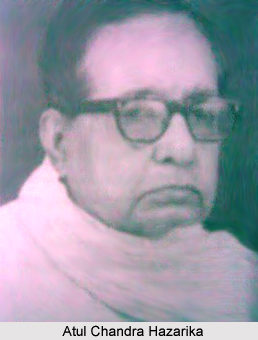 Atul Hazarika (190- 1986) writes like a man who has gone into a library of harnessed emotions. The poet has a number of bird-poems: Dahikatara, Patmadai and flower-poems like Kanchan, Indramalali to his credit. His attitude towards nature is of the Wordsworthian romantic type. Devadasi is one of Hazarika`s best poems ever. In Devi tie rakshashi, the patriotic idea is conveyed through a metaphor. His nature-poems like Varsamangal, Barisardak have a distinct message for man. Mahaprashan is considered as an elegy on Laksminath Bezbaroa. Besides patriotic poems, the other significant poem of Hazarika is Mor puja. Balichar describes the sandbanks of Brahmaputra River that glimmers under sunlight.
Atul Hazarika (190- 1986) writes like a man who has gone into a library of harnessed emotions. The poet has a number of bird-poems: Dahikatara, Patmadai and flower-poems like Kanchan, Indramalali to his credit. His attitude towards nature is of the Wordsworthian romantic type. Devadasi is one of Hazarika`s best poems ever. In Devi tie rakshashi, the patriotic idea is conveyed through a metaphor. His nature-poems like Varsamangal, Barisardak have a distinct message for man. Mahaprashan is considered as an elegy on Laksminath Bezbaroa. Besides patriotic poems, the other significant poem of Hazarika is Mor puja. Balichar describes the sandbanks of Brahmaputra River that glimmers under sunlight.
Devadasi is a poem of a Devadasi who is determined to touch the marble heart of the temple deity through dance and music. His other poetical works are Manimala, Mukutamala (1930), Panchajanya (1931), Dipali (1938). He uses verse for mythological and prose for historical plays. Ahuti is also written against the background of the freedom movement of 1942.
His mythological plays include Narakasur (1930), Beula (1933), Nanda dulal (1935), Kurushetra (1936), Ramchandra (1937), Champavati, Sakuntaia, Savitri (1939), Rukmini haran (1949) and Nirjita (1952). In Narakasur, fate dominates as a causal agent. In Beula, the dialogue is oratorical. The vidusak is modelled on the Shakespearean fool in Rukmini Haran. He could make his people talk naturally. His drams had crisp dialogues. Diction is fluent and characters are convincing. He was the author of more than one hundred books in Assamese language. He had given a new lease of life to the Assamese stage. He had also written many books for children. He compiled and edited several works of Laksminath Bezbaroa and at the same time he collected and published in "Moroha Phoolor Koroni".
He was one of those pioneers who were responsible for giving a new face to Bihu which is the national festival of Assam. He was also a great literary worker and was responsible for giving a new life to Oxom Xahitya Xabha in the fifties. In 1969 he was awarded Sahitya Akademi Award for Monchalekha. He also received a Padma Shri award in 1971.



















